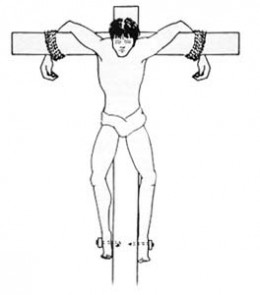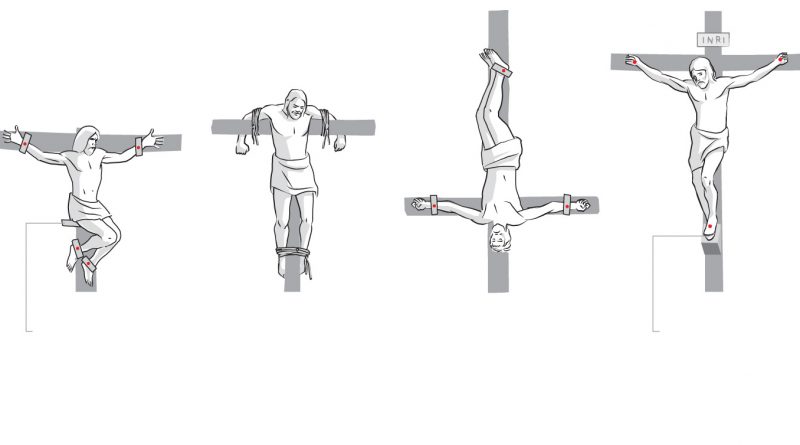What was Roman Crucifixion actually like? Jews find the ONLY evidence of crucifixion in history?
(006516.73:E-002257.55:N-WOM:R-UR:C-30:V)
[My Boer NAZI pal told me that nobody really knows what crucifixion in Roman times was exactly like. He said that crucifixion in Roman times was possibly tying someone to a pole and breaking their ribs with an iron bar.
I did some digging and almost every single reference to crucifixion is from Christians. I wanted to know what archaeologists, historians and scientists knew about crucifixion in Roman times.
Apparently the Israelis found the ONLY archaeological evidence of crucifixion ever. Now with these Jews, one has to be careful as to how much is real and how much is Jewish nonsense.
To me it seems as if, in order to hold a body up, you would need to tie the arms at the very least like in this diagram below relating to the only known example of crucifixion ever found.
 Below is a full article from BiblicalArchaeology about the only physical evidence ever found of crucifixion, and it was found in Israel. I am always wary of this stuff, because the Romans crucified thousands of rebels in Italy. Why have no remains been found in Italy? I’m sure there were a lot less crucifixions in (((Israel))) read: Palestine!!! So I’m wary of this being more of “Jewish Science”.
Below is a full article from BiblicalArchaeology about the only physical evidence ever found of crucifixion, and it was found in Israel. I am always wary of this stuff, because the Romans crucified thousands of rebels in Italy. Why have no remains been found in Italy? I’m sure there were a lot less crucifixions in (((Israel))) read: Palestine!!! So I’m wary of this being more of “Jewish Science”.
Here is the full article for what its worth! Some of the “Jewish science” below seems rather dodgy to me. Jan]
Roman Crucifixion Methods Reveal the History of Crucifixion
Crucifixion in Antiquity
• 07/17/2011
What do we know about the history of crucifixion? In the following article, “New Analysis of the Crucified Man,” Hershel Shanks looks at evidence of Roman crucifixion methods as analyzed from the remains found in Jerusalem of a young man crucified in the first century A.D. The remains included a heel bone pierced by a large nail, giving archaeologists, osteologists and anthropologists evidence of crucifixion in antiquity.

Crucifixion in antiquity was a gruesome execution, not really understood until a skeletal discovery in the 1980s that gave new insight into the history of crucifixion. Photo: Courtesy Israel Exploration Journal, Vol. 35, No. 1 (1985)
What do these bones tell us about the history of crucifixion? The excavator of the crucified man, Vassilios Tzaferis, followed the analysis of Nico Haas of Hebrew University-Hadassah Medical School in Jerusalem suggesting Roman crucifixion methods: a contorted position: arms nailed to the crossbeam; legs bent, twisted to one side, and held in place by a single nail that passed through a wooden plaque, through both left and right heel bones, and then into the upright of the cross.However, when Joseph Zias and Eliezer Sekeles reexamined the remains, looking for evidence of Roman crucifixion methods, they found no evidence that nails had penetrated the victim’s arms; moreover, the nail in the foot was not long enough to have penetrated the plaque, both feet, and the cross. And, indeed, what were previously thought to be fragments of two heel bones through which the nail passed were shown to be fragments of only one heel bone and a long bone. On the basis of this evidence, Zias and Sekeles suggest that the man’s legs straddled the cross and that his arms were tied to the crossbeam with ropes, signifying the method of crucifixion in antiquity.
Literary sources giving insight into the history of crucifixion indicate that Roman crucifixion methods had the condemned person carry to the execution site only the crossbar. Wood was scarce and the vertical pole was kept stationary and used repeatedly. Below, in “New Analysis of the Crucified Man,” Hershel Shanks concludes that crucifixion in antiquity involved death by asphyxiation, not death by nail piercing.
Scholars’ Corner: New Analysis of the Crucified Man
By Hershel Shanks

Drawing of the contorted crucifixion position proposed by Vassilios Tzaferis, based on the analysis of Nico Haas, which has since been challenged by Joseph Zias and Eliezer Sekeles. For full caption, see drawing from Israel Exploration Journal 35:1. Photo: Courtesy Israel Exploration Journal, Vol. 20, No. 1–2 (1970)
In our January/February 1985 issue, we published an article about the only remains of a crucified man to be recovered from antiquity (“Crucifixion—The Archaeological Evidence,” BAR, January/February 1985). Vassilios Tzaferis, the author of the article and the excavator of the crucified man, based much of his analysis of the victim’s position on the cross and other aspects of the method of crucifixion on the work of a medical team from Hebrew University-Hadassah Medical School headed by Nico Haas, who had analyzed the crucified man’s bones. In a recent article in the Israel Exploration Journal, however, Joseph Zias, an anthropologist with the Israel Department of Antiquities, and Eliezer Sekeles of Hebrew University-Hadassah Medical School in Jerusalem question many of Haas’s conclusions concerning the bones of the crucified man.a The questions Zias and Sekeles raise affect many of the conclusions about the man’s position during crucifixion.
According to Haas, the nail in the crucified man penetrated both his right and left heel bones, piercing the right heel bone (calcaneum) first, then the left. Haas found a fragment of bone attached to the right heel that he thought was part of the left heel bone (sustentaculum tali). If Haas’s analysis is correct, the two heel bones must have been penetrated by the same nail, and the victim’s legs must have been in a closed position on the cross.
But according to the new analysis of the bones just published in the Israel Exploration Journal, the bone fragment Haas identified as part of the left heel bone was incorrectly identified. “The shape and structure of this bony fragment is of a long bone; it cannot therefore be the left [heel bone],” say the most recent investigators. Their conclusions are confirmed by x-rays, which reveal the varying density, structure and direction of the bones.
Haas also incorrectly assumed that the nail is seven inches (17–18 cm) long. In fact, the total length of the nail from head to tip is only 4.5 inches (11.5 cm). A wooden plaque less than an inch thick (2 cm) had been punctured by the nail before it passed through the right heel bone. After exiting from the bone, the nail penetrated the cross itself and then bent, probably because it hit a knot. As the new investigators observe, given the length of the nail, “There simply was not enough room for both heel bones and a two centimeter wooden plaque to have been pierced by the nail and affixed to the vertical shaft of the cross. … The nail was sufficient for affixing only one heel bone to the cross.”
In short, only the right heel bone was penetrated—laterally, or sidewise—by the nail. Accordingly, the victim’s position on the cross must have been different from that portrayed by Haas.
The new investigators also dispute Haas’s conclusion that a scratch on the bone of the right forearm (radius) of the victim, just above the wrist, represents the penetration of a nail between the two bones of the forearm. According to Zias and Sekeles, such scratches and indentations are commonly found on ancient skeletal material, including on the right leg bone (fibula) of this man. Such scratches and indentations have nothing to do with crucifixion.
How then was the crucified man attached to the cross?
As the new investigators observe:
“The literary sources for the Roman period contain numerous descriptions of crucifixion but few exact details as to how the condemned were affixed to the cross. Unfortunately, the direct physical evidence here is also limited to one right calcaneum (heel bone) pierced by an 11.5 cm iron nail with traces of wood at both ends.”
According to the literary sources, those condemned to crucifixion never carried the complete cross, despite the common belief to the contrary and despite the many modern reenactments of Jesus’ walk to Golgotha. Instead, only the crossbar was carried, while the upright was set in a permanent place where it was used for subsequent executions. As the first-century Jewish historian Josephus noted, wood was so scarce in Jerusalem during the first century A.D. that the Romans were forced to travel ten miles from Jerusalem to secure timber for their siege machinery.
According to Zias and Sekeles:
“One can reasonably assume that the scarcity of wood may have been expressed in the economics of crucifixion in that the crossbar as well as the upright would be used repeatedly. Thus, the lack of traumatic injury to the forearm and metacarpals of the hand seems to suggest that the arms of the condemned were tied rather than nailed to the cross. There is ample literary and artistic evidence for the use of ropes rather than nails to secure the condemned to the cross.”
According to Zias and Sekeles, the victim’s legs straddled the vertical shaft of the cross, one leg on either side, with the nails penetrating the heel bones. The plaque or plate under the head of the nail, they say, was intended to secure the nail and prevent the condemned man from pulling his feet free.
As Haas correctly suggested, the nail probably hit a knot which bent the nail. However, as Zias and Sekeles reconstruct the removal of the dead man from the cross:
“Once the body was removed from the cross, albeit with some difficulty in removing the right leg, the condemned man’s family would now find it impossible to remove the bent nail without completely destroying the heel bone. This reluctance to inflict further damage to the heel led [to his burial with the nail still in his bone, and this in turn led] to the eventual discovery of the crucifixion.”
Whether the victim’s arms were tied, rather than nailed to the cross is irrelevant to the manner of his dying. As Zias and Sekeles point out:
“Death by crucifixion was the result of the manner in which the condemned man hung from the cross and not the traumatic injury caused by nailing. Hanging from the cross resulted in a painful process of asphyxiation, in which the two sets of muscles used for breathing, the intercostal [chest] muscles and the diaphragm, became progressively weakened. In time, the condemned man expired, due to the inability to continue breathing properly.”
Video & Audio: Rockwell: ALL Whites EVERYWHERE need Political Armies Waging Political Warfare
The awesome White American man, George Lincoln Rockwell, came up with the idea that Whites needed a Balanced Political Army. In this video I chat to Robert (Mosely), an American guy I know in the movement and we discuss Rockwell as well as his ideas and what it means.
White Shop: 20 x George Lincoln Rockwell Stickers
These are Glossy, high quality stickers. These are about 3 inches by 3 inches. Pack of 20 stickers.
5 Photos: The Worlds First true White (NAZI) Wolf: American: Joseph Paul Franklin Killed 22
One of my readers mentioned to me that the first white wolf was this American guy. And I went and browsed his background.

